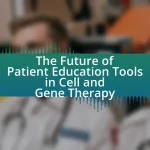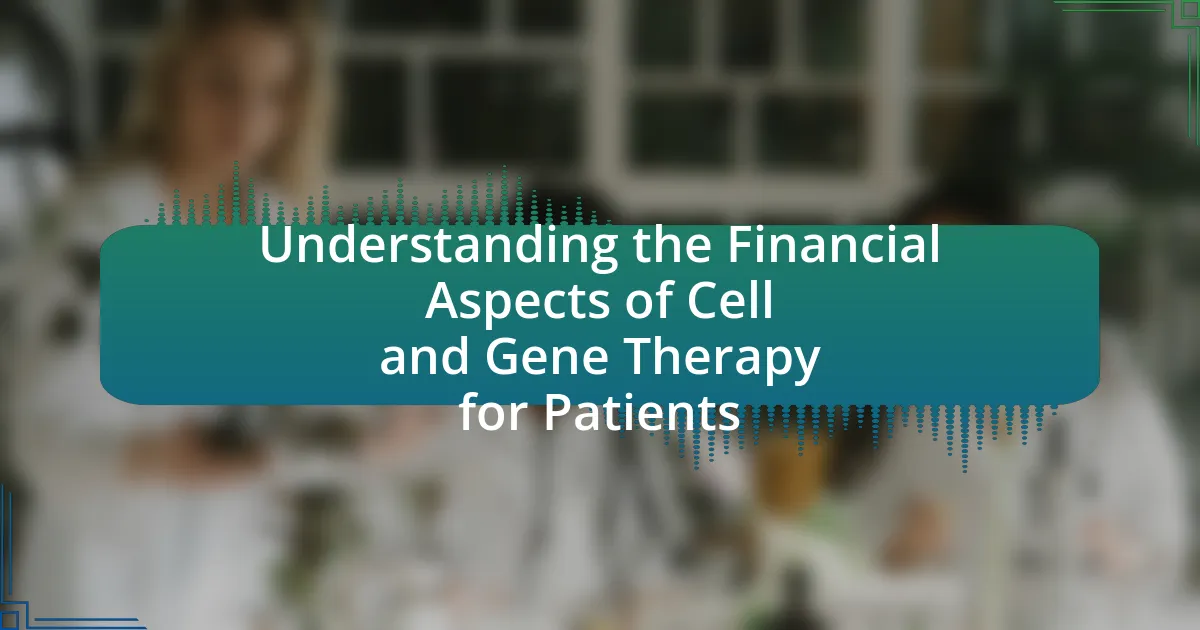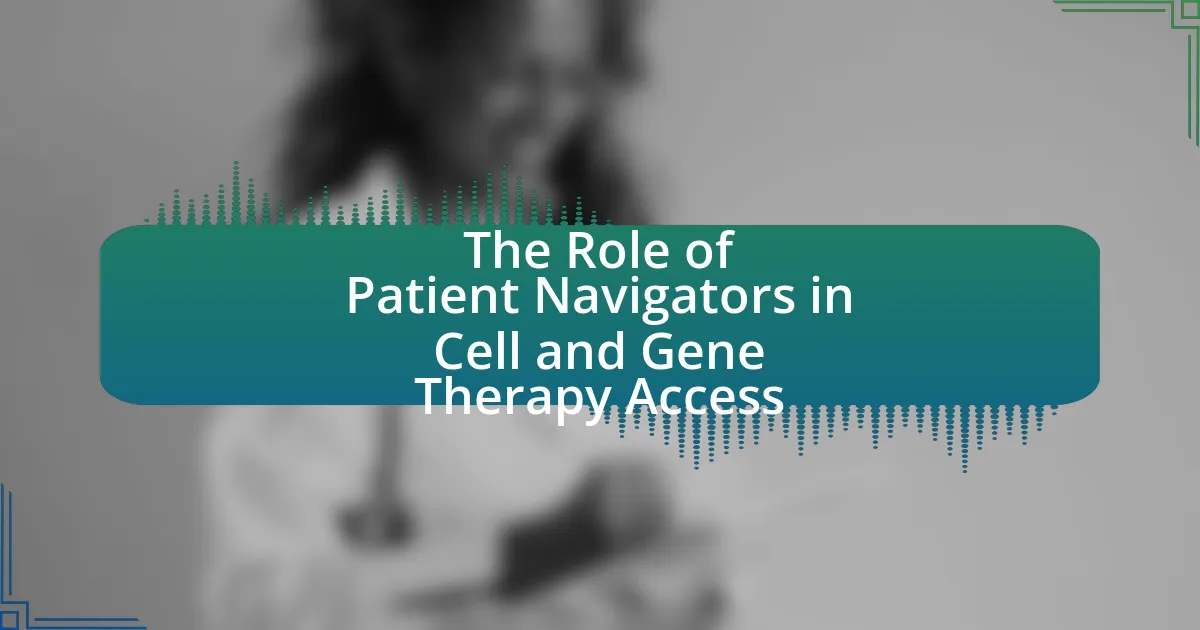The article examines the ethical considerations of patient education in innovative therapies, emphasizing the importance of informed consent, transparency, and the prevention of coercion. It highlights how effective patient education empowers individuals to make informed decisions, leading to better adherence to treatment regimens and improved health outcomes. Key ethical principles guiding this process include autonomy, beneficence, non-maleficence, and justice, which collectively enhance patient engagement and trust in healthcare. The article also addresses challenges in educating patients, such as varying health literacy levels and the complexity of innovative therapies, while proposing strategies for effective communication and tailored education to optimize patient understanding and care.

What are the Ethical Considerations of Patient Education in Innovative Therapies?
The ethical considerations of patient education in innovative therapies include informed consent, transparency, and the potential for coercion. Informed consent requires that patients fully understand the risks and benefits of new treatments, which is crucial given the complexity of innovative therapies. Transparency involves providing clear and accessible information about the therapy’s efficacy and safety, as evidenced by studies indicating that patients who receive comprehensive education are more likely to make informed decisions (Fisher et al., 2020, Journal of Medical Ethics). Additionally, the risk of coercion arises when patients feel pressured to accept new therapies due to their novelty or the enthusiasm of healthcare providers, which can undermine autonomy. These considerations are essential to ensure ethical patient engagement and uphold the principles of beneficence and non-maleficence in healthcare.
Why is patient education crucial in the context of innovative therapies?
Patient education is crucial in the context of innovative therapies because it empowers patients to make informed decisions about their treatment options. Informed patients are more likely to adhere to complex treatment regimens, which is essential for the effectiveness of innovative therapies that may involve novel mechanisms or side effects. Research indicates that patients who receive comprehensive education about their therapies demonstrate improved health outcomes and satisfaction levels. For instance, a study published in the Journal of Clinical Oncology found that patient education significantly increased adherence rates in cancer treatments, highlighting the direct correlation between understanding and treatment success.
What role does informed consent play in patient education?
Informed consent is crucial in patient education as it ensures that patients understand the risks, benefits, and alternatives of proposed treatments. This process empowers patients to make informed decisions about their healthcare, fostering autonomy and trust in the patient-provider relationship. Research indicates that effective informed consent can lead to better patient satisfaction and adherence to treatment plans, as patients who are well-informed are more likely to engage actively in their care. For instance, a study published in the Journal of Medical Ethics highlights that patients who receive comprehensive information about their treatment options report higher levels of understanding and confidence in their decisions.
How does patient understanding impact treatment outcomes?
Patient understanding significantly impacts treatment outcomes by enhancing adherence to medical advice and improving communication between patients and healthcare providers. When patients comprehend their conditions and treatment plans, they are more likely to follow prescribed regimens, which has been shown to lead to better health results. For instance, a study published in the Journal of Health Communication found that patients with a clear understanding of their treatment were 1.5 times more likely to adhere to medication schedules compared to those who did not fully grasp their treatment plans. This adherence directly correlates with improved clinical outcomes, such as reduced hospital readmissions and better management of chronic diseases.
What ethical principles guide patient education in healthcare?
The ethical principles that guide patient education in healthcare include autonomy, beneficence, non-maleficence, and justice. Autonomy emphasizes the patient’s right to make informed decisions about their own care, ensuring they have access to all necessary information. Beneficence involves providing education that promotes the well-being of patients, while non-maleficence focuses on avoiding harm through accurate and clear communication. Justice ensures equitable access to educational resources for all patients, regardless of their background. These principles are foundational in fostering trust and improving health outcomes in innovative therapies.
How do autonomy and beneficence relate to patient education?
Autonomy and beneficence are fundamental ethical principles that significantly influence patient education. Autonomy refers to the patient’s right to make informed decisions about their own healthcare, while beneficence emphasizes the healthcare provider’s obligation to act in the best interest of the patient. Effective patient education empowers individuals to understand their treatment options, thereby enhancing their autonomy. For instance, when patients receive comprehensive information about innovative therapies, they can make choices that align with their values and preferences. Simultaneously, beneficence is upheld as healthcare providers ensure that the information shared is accurate, relevant, and promotes the patient’s well-being. This dual focus on respecting patient autonomy and promoting beneficence fosters a collaborative healthcare environment, ultimately leading to improved patient outcomes and satisfaction.
What are the implications of non-maleficence in patient education?
Non-maleficence in patient education implies that healthcare providers must ensure that the information shared does not cause harm to patients. This principle mandates that educators carefully evaluate the accuracy and clarity of the information provided, as misleading or overly complex explanations can lead to confusion, anxiety, or poor health decisions. For instance, a study published in the Journal of Medical Ethics highlights that clear communication significantly reduces the risk of patient misunderstanding, which can lead to adverse health outcomes. Therefore, adherence to non-maleficence in patient education is crucial for fostering trust and promoting patient safety in innovative therapies.
What challenges arise in educating patients about innovative therapies?
Educating patients about innovative therapies presents several challenges, primarily due to the complexity of the therapies and the varying levels of health literacy among patients. The intricate nature of innovative therapies often involves advanced scientific concepts that can be difficult for patients to understand, leading to potential misinterpretations of the treatment’s benefits and risks. Additionally, patients may have limited prior knowledge about the specific conditions being treated, which can hinder their ability to engage in informed decision-making. Research indicates that approximately 90 million adults in the U.S. have difficulty understanding health information, which exacerbates these challenges. Furthermore, the rapid pace of innovation in medical therapies can result in outdated information being disseminated, complicating the education process. These factors collectively contribute to the difficulty in ensuring that patients are adequately informed and able to make sound decisions regarding their treatment options.
How do health literacy levels affect patient education efforts?
Health literacy levels significantly influence patient education efforts by determining patients’ ability to understand health information and make informed decisions about their care. Higher health literacy enables patients to comprehend medical instructions, engage in discussions with healthcare providers, and adhere to treatment plans, thereby improving health outcomes. Conversely, low health literacy can lead to misunderstandings, decreased adherence to medical advice, and poorer health outcomes. For instance, a study published in the Journal of Health Communication found that patients with low health literacy were more likely to misinterpret prescription labels and medication instructions, which directly impacts their ability to manage their health effectively.
What ethical dilemmas can arise from misinformation or lack of information?
Misinformation or lack of information can lead to significant ethical dilemmas, particularly in the context of patient education in innovative therapies. One primary dilemma is the potential for patients to make uninformed decisions regarding their health, which can result in harm or ineffective treatment outcomes. For instance, if patients receive inaccurate information about the risks and benefits of a new therapy, they may choose to undergo a treatment that is not suitable for their condition, leading to adverse effects or deterioration of their health.
Additionally, healthcare providers face ethical challenges when they must navigate the consequences of misinformation. They may struggle to maintain trust with patients while correcting false beliefs or addressing gaps in understanding. This situation can create a conflict between the obligation to provide accurate information and the fear of causing distress or confusion among patients.
Moreover, the dissemination of misinformation can exacerbate health disparities, as marginalized groups may be more susceptible to false information due to limited access to reliable sources. This inequity raises ethical concerns about justice and fairness in healthcare, as it can lead to unequal treatment outcomes based on the quality of information available to different populations.
In summary, the ethical dilemmas arising from misinformation or lack of information include the risk of harm from uninformed patient choices, challenges in maintaining trust between providers and patients, and the potential for exacerbating health disparities.
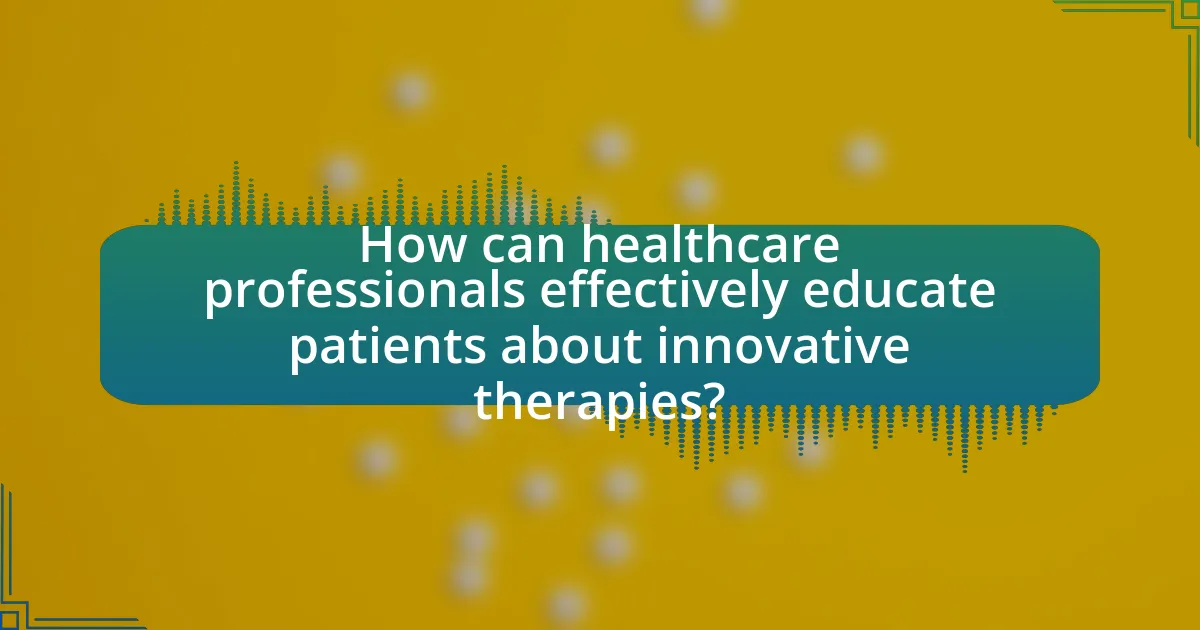
How can healthcare professionals effectively educate patients about innovative therapies?
Healthcare professionals can effectively educate patients about innovative therapies by utilizing clear communication, tailored information, and interactive engagement. Clear communication ensures that complex medical concepts are simplified, making them accessible to patients. Tailored information addresses individual patient needs, preferences, and health literacy levels, which enhances understanding and retention. Interactive engagement, such as discussions and Q&A sessions, fosters a supportive environment where patients feel comfortable asking questions and expressing concerns. Research indicates that patients who receive personalized education are more likely to adhere to treatment plans and report higher satisfaction levels (McCoy et al., 2016, Journal of Patient Experience).
What strategies can be employed to enhance patient understanding?
To enhance patient understanding, healthcare providers can employ strategies such as using plain language, visual aids, and teach-back methods. Plain language simplifies complex medical terminology, making information more accessible; studies show that patients retain more information when it is presented clearly. Visual aids, including diagrams and videos, can illustrate concepts that may be difficult to grasp through text alone, improving comprehension. The teach-back method involves asking patients to explain back what they have learned, ensuring they understand the information correctly. Research indicates that this approach significantly increases patient engagement and retention of information, ultimately leading to better health outcomes.
How can visual aids and technology improve patient education?
Visual aids and technology enhance patient education by making complex medical information more accessible and understandable. For instance, interactive tools like videos and animations can illustrate procedures or conditions, leading to better comprehension among patients. Research indicates that patients who engage with visual aids retain information more effectively; a study published in the Journal of Medical Internet Research found that multimedia resources improved knowledge retention by 50% compared to traditional methods. Additionally, technology such as mobile health applications allows for personalized education, enabling patients to access tailored information at their convenience, which further supports their learning and decision-making processes.
What role does empathy play in effective patient communication?
Empathy is crucial in effective patient communication as it fosters trust and understanding between healthcare providers and patients. When healthcare professionals demonstrate empathy, they are better able to comprehend patients’ feelings, concerns, and perspectives, which enhances the quality of interactions. Research indicates that empathetic communication can lead to improved patient satisfaction, adherence to treatment plans, and overall health outcomes. For instance, a study published in the Journal of General Internal Medicine found that patients who perceived their physicians as empathetic were more likely to follow medical advice and report higher satisfaction levels. This evidence underscores the significant role empathy plays in facilitating meaningful dialogue and promoting positive healthcare experiences.
What are the best practices for ensuring ethical patient education?
The best practices for ensuring ethical patient education include providing accurate, clear, and comprehensive information tailored to the patient’s needs. Healthcare providers should prioritize informed consent by ensuring patients understand their treatment options, risks, and benefits. This can be supported by using plain language and visual aids to enhance comprehension. Additionally, respecting patient autonomy is crucial; patients should be encouraged to ask questions and express their preferences. Evidence from studies, such as the one published in the Journal of Medical Ethics, indicates that effective communication significantly improves patient understanding and satisfaction, thereby reinforcing the ethical obligation of healthcare professionals to educate patients responsibly.
How can healthcare providers assess patient comprehension?
Healthcare providers can assess patient comprehension through various methods, including teach-back techniques, open-ended questions, and comprehension assessments. Teach-back involves asking patients to explain back the information provided to them, ensuring they understand the key points. Open-ended questions allow providers to gauge patients’ understanding by encouraging them to elaborate on their thoughts. Comprehension assessments, such as quizzes or surveys, can quantitatively measure understanding of specific information. Research indicates that these methods enhance patient engagement and retention of information, ultimately leading to better health outcomes.
What methods can be used to tailor education to individual patient needs?
Tailoring education to individual patient needs can be effectively achieved through personalized learning plans, which involve assessing the patient’s unique health literacy, preferences, and learning styles. This method allows healthcare providers to customize educational materials and delivery methods, ensuring that information is accessible and relevant to each patient. For instance, studies have shown that using visual aids and interactive tools can enhance understanding for patients with lower health literacy, while more detailed, technical information may benefit those with higher literacy levels. Additionally, incorporating feedback mechanisms enables continuous adjustment of educational approaches based on patient responses, further enhancing the effectiveness of the education provided.
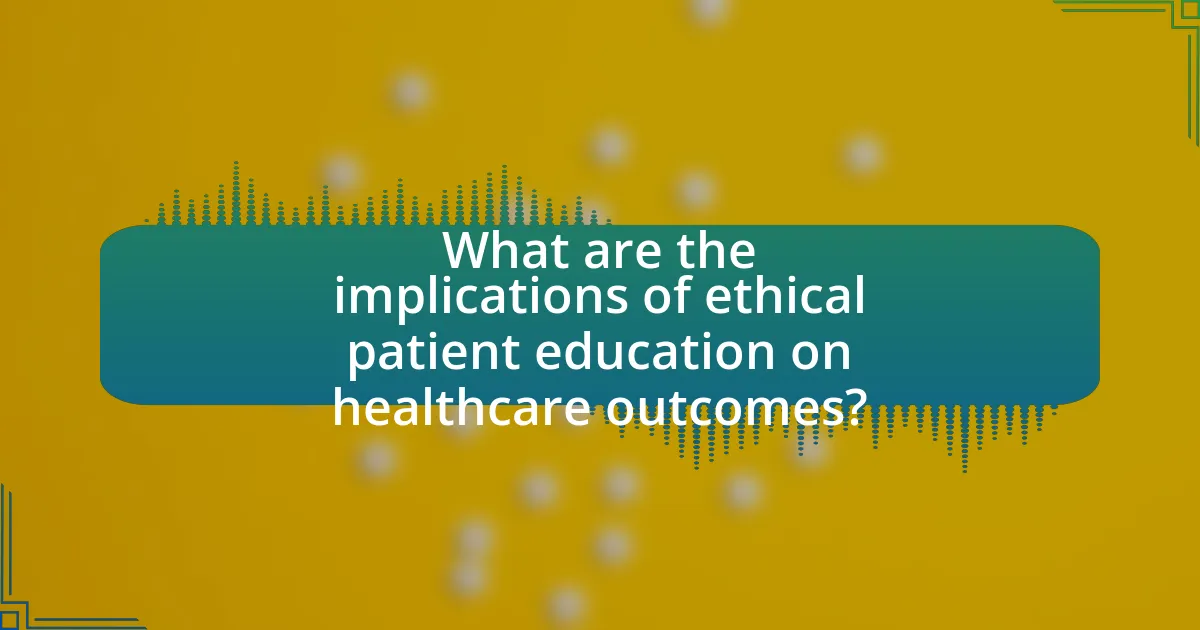
What are the implications of ethical patient education on healthcare outcomes?
Ethical patient education significantly improves healthcare outcomes by enhancing patient understanding, adherence to treatment plans, and overall satisfaction with care. When patients receive accurate, clear, and respectful information about their conditions and treatment options, they are more likely to engage in shared decision-making, which has been shown to lead to better health outcomes. For instance, a study published in the Journal of the American Medical Association found that patients who were well-informed about their treatment options had a 30% higher adherence rate to prescribed therapies compared to those who were not adequately educated. This adherence directly correlates with improved clinical outcomes, such as reduced hospital readmissions and better management of chronic diseases. Therefore, ethical patient education serves as a critical component in optimizing healthcare delivery and enhancing patient health results.
How does ethical patient education influence patient adherence to therapies?
Ethical patient education significantly enhances patient adherence to therapies by fostering trust and understanding between healthcare providers and patients. When patients receive clear, honest, and comprehensive information about their treatment options, including potential risks and benefits, they are more likely to engage actively in their care. Research indicates that informed patients are 1.5 to 2 times more likely to adhere to prescribed therapies compared to those who are not adequately educated. This adherence is further supported by ethical practices that respect patient autonomy, allowing individuals to make informed decisions aligned with their values and preferences.
What evidence supports the link between education and treatment success?
Education significantly enhances treatment success, as evidenced by numerous studies demonstrating that informed patients are more likely to adhere to treatment protocols. For instance, a meta-analysis published in the Journal of Medical Internet Research found that patient education interventions improved adherence rates by 25% across various chronic conditions. Additionally, research conducted by the American Journal of Public Health indicated that patients with higher health literacy levels reported better health outcomes and were more engaged in their treatment processes. These findings collectively underscore the critical role of education in achieving successful treatment outcomes.
How can ethical education reduce healthcare disparities?
Ethical education can reduce healthcare disparities by equipping healthcare professionals with the knowledge and skills to recognize and address biases in treatment. This education fosters a deeper understanding of social determinants of health, enabling providers to deliver more equitable care. For instance, studies have shown that training in cultural competence leads to improved patient-provider communication and satisfaction, which can significantly enhance health outcomes in marginalized communities. By promoting ethical principles such as justice and respect for persons, ethical education encourages healthcare providers to advocate for vulnerable populations, ultimately contributing to a reduction in disparities.
What future trends may impact patient education in innovative therapies?
Future trends that may impact patient education in innovative therapies include the integration of artificial intelligence, personalized medicine, and telehealth technologies. Artificial intelligence can enhance educational materials by providing tailored information based on individual patient data, improving comprehension and engagement. Personalized medicine allows for education that is specific to a patient’s genetic makeup and treatment response, ensuring that patients receive relevant information that directly pertains to their therapy. Telehealth technologies facilitate remote education, making it easier for patients to access information and support from healthcare providers, regardless of their location. These trends are supported by studies indicating that personalized and accessible education improves patient outcomes and adherence to treatment plans.
How might advancements in technology shape patient education practices?
Advancements in technology significantly shape patient education practices by enhancing accessibility, personalization, and engagement. For instance, telehealth platforms allow patients to access educational resources and consultations remotely, increasing the reach of educational materials. Additionally, mobile health applications can provide tailored information based on individual health conditions, improving the relevance of the content delivered. Research indicates that interactive tools, such as virtual reality simulations, can enhance understanding of complex medical procedures, leading to better patient comprehension and retention of information. These technological innovations not only facilitate better communication between healthcare providers and patients but also empower patients to take an active role in their health management, ultimately improving health outcomes.
What role will regulatory changes play in ethical patient education?
Regulatory changes will significantly enhance ethical patient education by establishing clear guidelines and standards for information dissemination. These changes can ensure that patients receive accurate, comprehensive, and unbiased information about innovative therapies, which is crucial for informed consent. For instance, regulations like the FDA’s requirement for clear labeling and patient information sheets help mitigate misinformation and promote transparency. Furthermore, regulatory frameworks can mandate training for healthcare providers on ethical communication, thereby improving the quality of patient education. This alignment of regulations with ethical standards ultimately fosters trust between patients and healthcare providers, ensuring that patients are well-informed about their treatment options.
What practical tips can healthcare professionals follow for ethical patient education?
Healthcare professionals can follow several practical tips for ethical patient education, including ensuring informed consent, providing clear and accurate information, and respecting patient autonomy. Informed consent involves explaining treatment options, risks, and benefits in a way that patients can understand, which is essential for ethical practice. Providing clear and accurate information helps patients make informed decisions about their care, as studies show that patients who understand their treatment options are more likely to adhere to their care plans. Respecting patient autonomy means acknowledging and supporting patients’ rights to make their own healthcare decisions, which is a fundamental ethical principle in healthcare.


